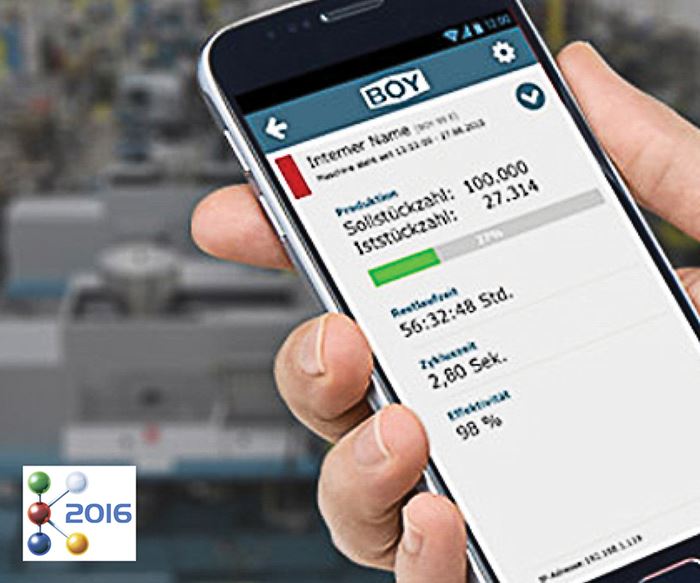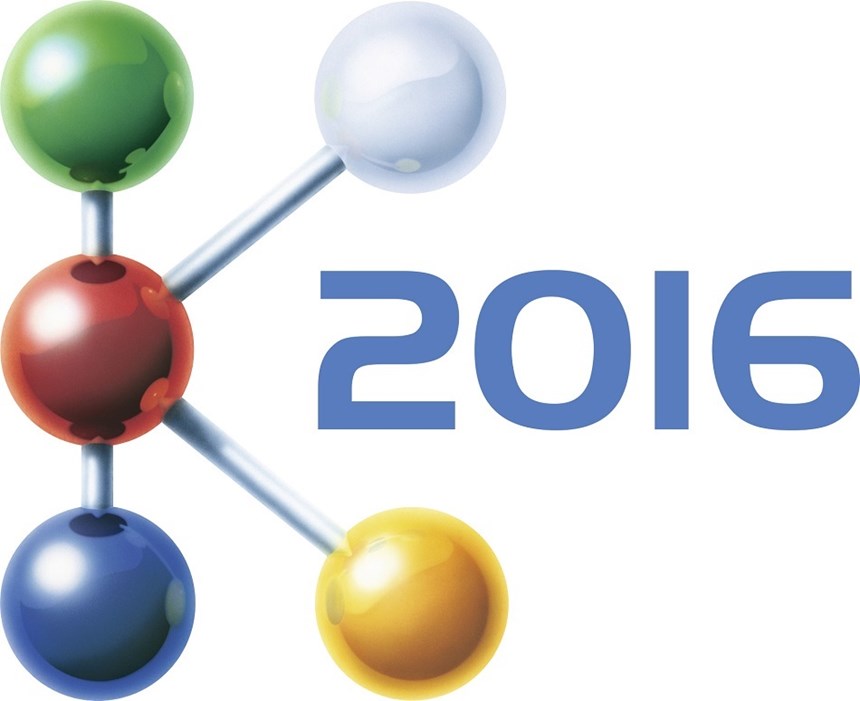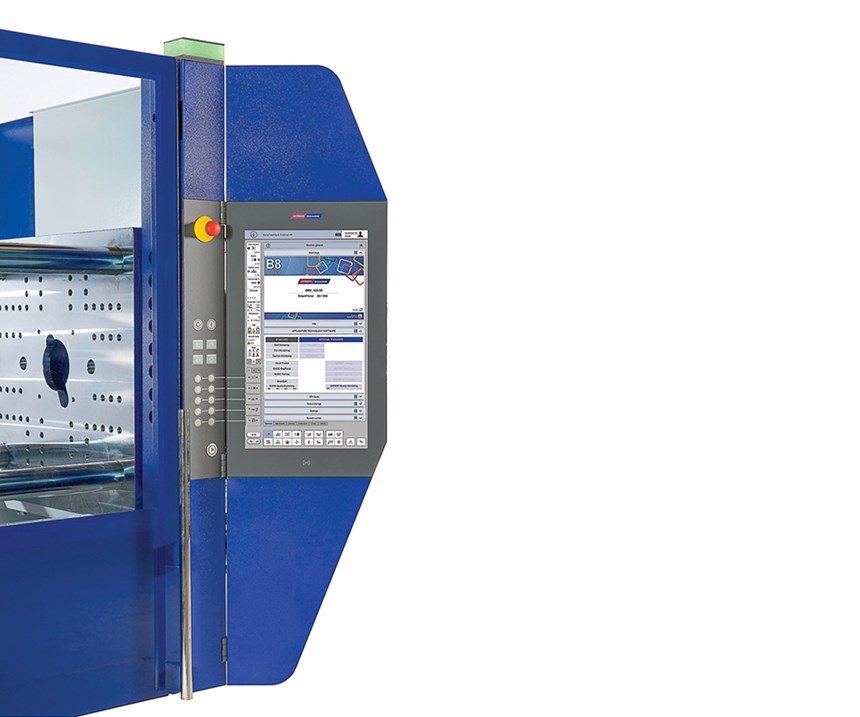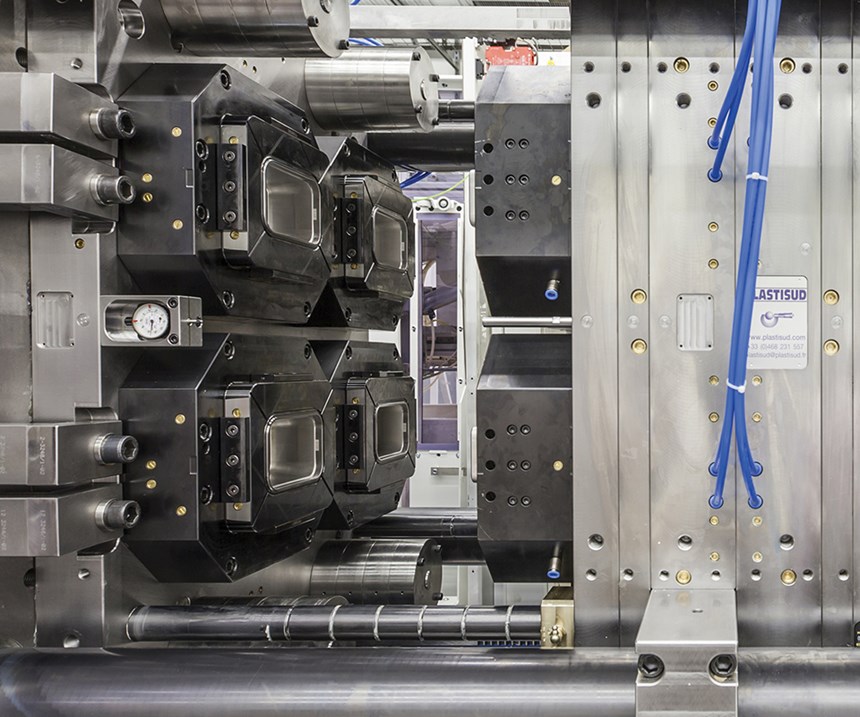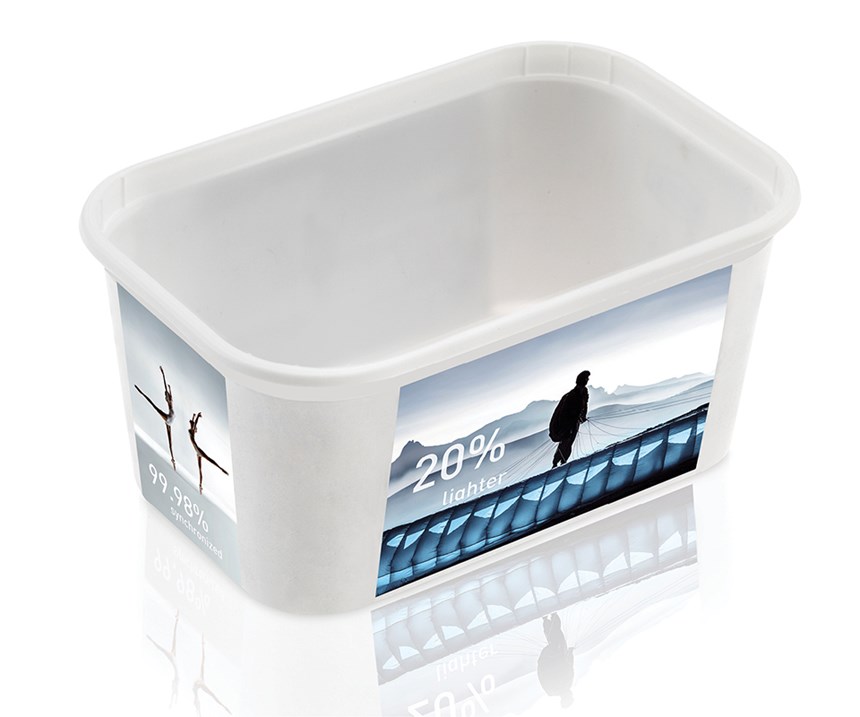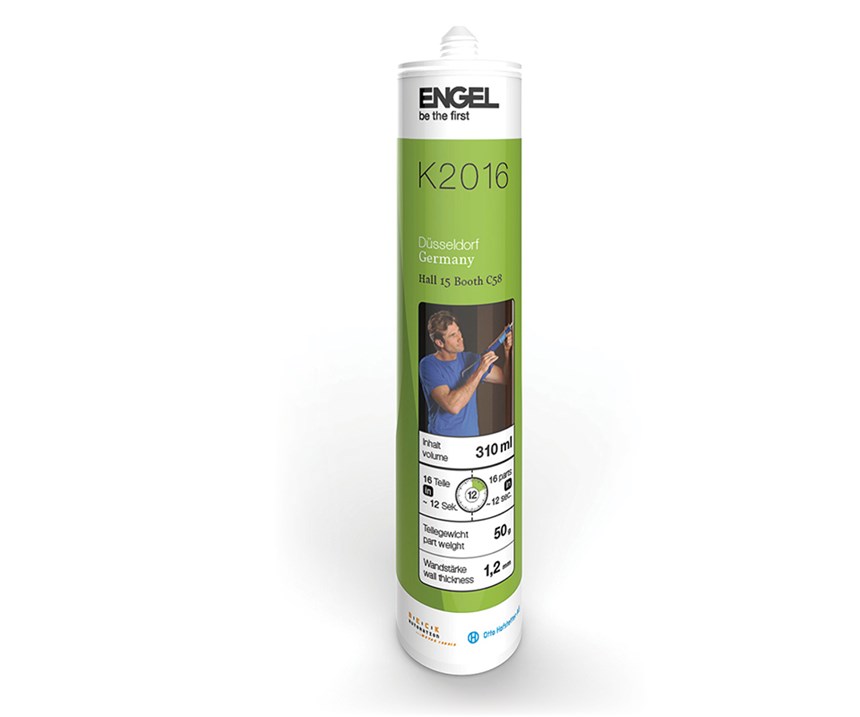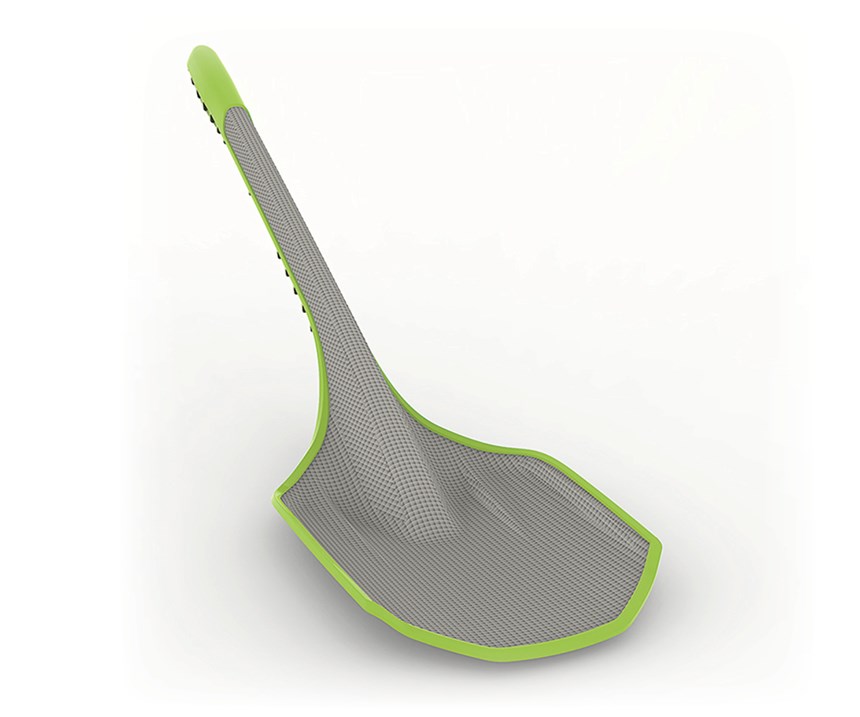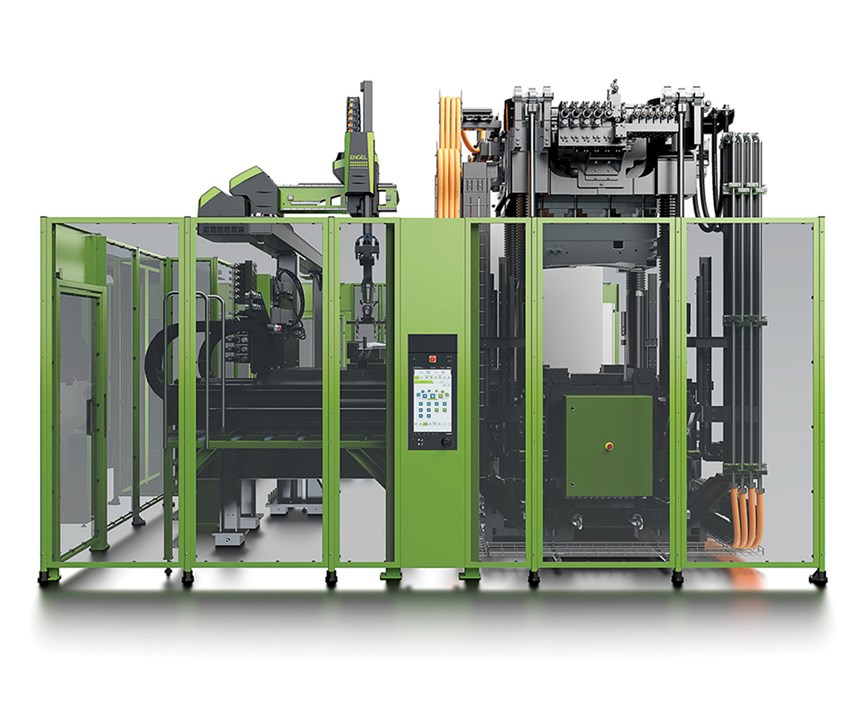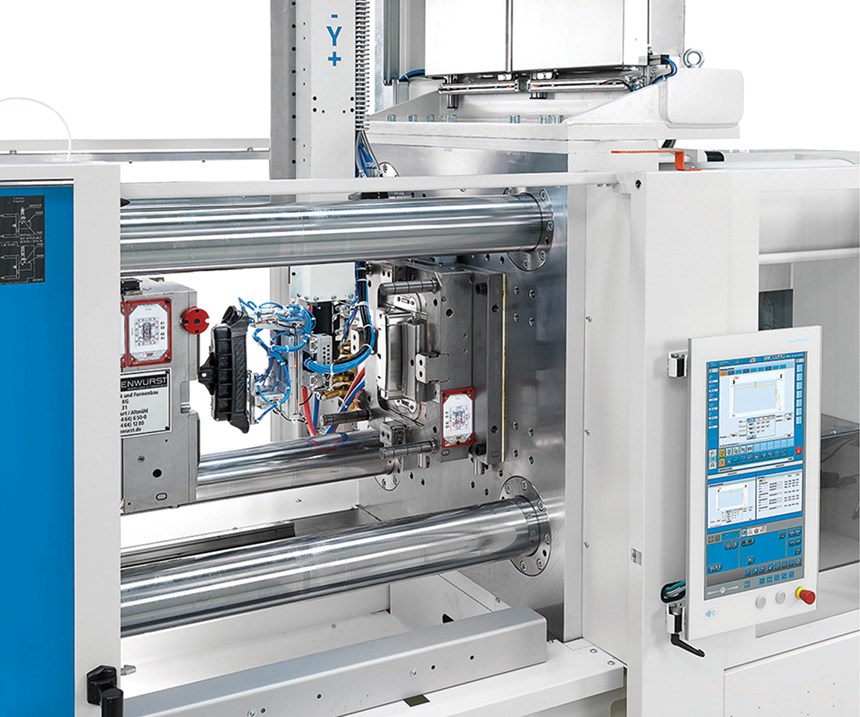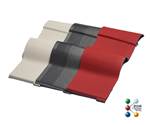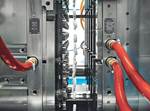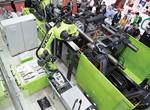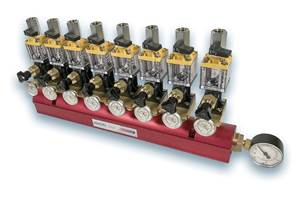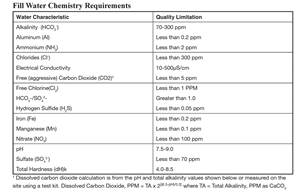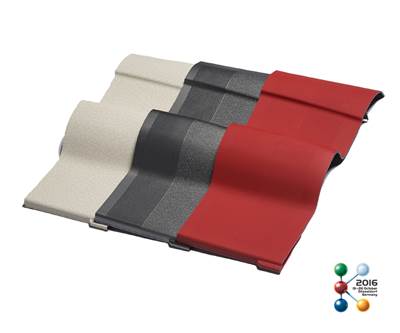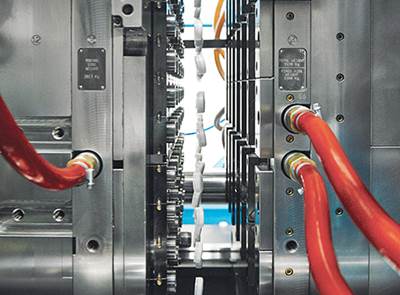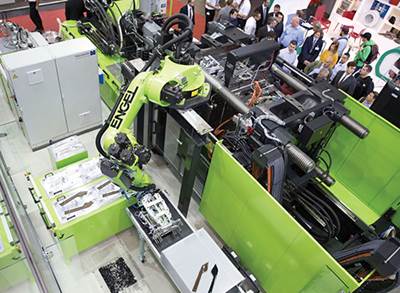K 2016 Preview: Injection Molding
Adapting injection molding to the concept of Industry 4.0 is gaining momentum. At this show you’ll see that the interconnected, integrated “factory of the future” is almost here.
The new frontier of the “Smart Factory” will be one of the one of the most prominent themes among major injection machinery manufacturers. Part of the background buzz at recent shows, where only a couple of machine builders drew much attention to the subject, it will now be front and center in at least a half-dozen exhibits. Suppliers such as Arburg, Boy, Engel, KraussMaffei, Sumitomo Demag, Wittmann Battenfeld, and robot supplier Sepro will try to bring into sharper focus the still somewhat loose concept of self-regulating systems of interlinked machines and components. As Arburg puts it, “Innovative machine manufacturers are rebranding themselves as suppliers of flexible production systems for IT-networked production in the smart factory.”
In Europe, the popular umbrella term for all this is “Industry 4.0,” though individual OEMs have coined numerous variants, such as “Inject 4.0” (Engel), “Plastics 4.0” (KraussMaffei), “Wittmann 4.0” (Wittmann Battenfeld), and even “Electrified 4.0” (Sumitomo Demag).
That’s by no means all that will attract attention at K 2016. There will be plenty of new machines, with particular emphasis on higher speeds for packaging and medical markets. With a dazzling variety of automated cells, exhibitors will emphasize a number of specialized areas of molding for automotive, packaging, medical, and consumer electronics.
INDUSTRY 4.0 IS STARTING TO GEL
One factor that may be contributing to the greater visibility of Industry 4.0 at this show is the effort of Euromap, the European machinery association, to codify a new industrial standard for communication between “smart” machines, plant computers, and remote human observers. This standard goes by the name OPC-UA, for Open Platform Communication—Unified Architecture. The key word is “open” and the main attraction of this protocol is said to be its “universal” cross-platform adaptability. Engel, KM, Sumitomo, and Wittmann have mentioned specifically that their implementation of Industry 4.0 is based on OPC-UA.
As reported in last month’s Keeping Up, WITTMANN (U.S. office in Torrington, Conn.) will debut its new Wittmann 4.0 Router, “the gateway to the workcell,” which is compatible with OPC-UA. This device accepts only Wittmann 4.0 communications and automatically assigns IP addresses to Wittman 4.0 equipment in the workcell.
Also reported last month, Wittmann’s biggest introduction at the show is the new Unilog B8 controller for all its injection machines. It has a larger, 21.5-in. color multi-touch screen, capable of displaying two pages at once, and it runs under the new Windows 10 IoT (“internet of things”) operating system.
As a demonstration of the remote communications capability fundamental to Industry 4.0, Wittmann Battenfeld will show a machine in its new all-electric EcoPower Medical series, running in a cell within a clean room, but operated from outside the clean room via tablet. Wittmann will also run an 1100-ton MacroPower press in the first public demonstration of its Condition Monitoring System (CMS), part of its “Smart Services” for Industry 4.0. Key machine status data will be measured by sensors, processed by the machine’s controller, and passed on to a corporate or plant MES system for maintenance planning.
Wittmann Battenfeld will also network a press and peripheral equipment via Wittmann 4.0 in a demonstration of individualized production. Visitors can enter their names into a computer terminal and receive a printed QR code. When that code is scanned at another station, the next part produced will be transferred to a station where it will be laser printed with the visitor’s name. The parts will be handled by a Wittmann robot using the brand-new R9 control system.
At several recent international shows, Arburg has demonstrated its readiness for Industry 4.0 through similar demonstrations of individualized production. Arburg (U.S. office in Rocky Hill, Conn.) will again present a mini smart factory linking an Allrounder injection machine with its Freeformer 3D printer and a seven-axis robot.
Engel (U.S. office in York, Pa.) is implementing OPC-UA to interlink its e-flomo electronic flow control with a new water-temperature control unit with variable-speed pumps, jointly developed by Engel and HB-Therm of Switzerland. The two devices are integrated within Engel’s CC300 machine controller and are coordinated via brand-new iQ flow control software. As reported in last month’s Close Up, this companion to Engel’s iQ weight control and iQ clamp control is said to find automatically the optimum water-flow rate for the mold and provide only the flow necessary for optimum cooling according to a preset ΔT (in/out water-temperature difference), thereby saving up to 80% of mold-cooling energy.
KraussMaffei’s current “Plastics 4.0” strategy will be implemented in several ways at K to highlight the three essential components of the smart factory: intelligent machines, networked production processes, and interactive service. In the category of intelligent machines, KM (U.S. office in Florence, Ky.) will show off its newly enhanced APC Plus software. Introduced in 2014, APC (Adaptive Process Control) detects and adjusts for changing ambient conditions or resin viscosity. New functions in the “Plus” version include support for multi-component molding and liquid silicone rubber (LSR).
In the integrated production category, KM will again show its FiberForm process of overmolding organic sheet composites. This time, all quality-oriented process data—such as organic-sheet heating curves, injection- and cavity-pressure curves—is not only recorded in a KM database, but is documented for each individual part with a printed QR code label that is stuck on the part. This makes it possible to trace all product and process data for each part anywhere via cell phone, tablet, or PC.
Also new is KM’s DataXplorer, an open system for recording and analyzing comprehensive process data in injection molding as well as upstream and downstream processes. “The modular design and easy configurability allow the system to adapt to all tasks and to be scalable in size,” says Dr. Reinhard Schiffers, head of machine technology. Other Plastics 4.0 tools for monitoring machines at K will include webcam applications and a central computer interface standardized for networking machines based on OPC-UA.
And for the third leg of the “4.0” stool, KM is showing a new interactive service tool utilizing OPC-UA. The E-Service platform, available through the KM, Netstal, and Berstorff websites, lets the customer access current machine and production data using the live monitoring function. A user-configurable dashboard provides information on the machine history and diagnostic reports in case of a problem. A ticketing and optional remote maintenance system are parts of the platform, as are the options to transfer information via QR code and smartphone app. Spare parts can be ordered via the integrated online store.
Engel’s new entry in the “smart service” category is the e-connect.monitor module for 24-hr continuous remote monitoring of machine conditions to schedule maintenance, predict wear or component failures, and maximize machine availability by reducing both planned and unplanned downtime. As reported in last month’s Close Up, the first two diagnostic modules are designed to monitor screw wear without pulling the screw, using new ultrasonic technology with sensors outside the barrel; and to monitor the condition of ballscrews on electric servo axes.
Sumitomo (SHI) Demag (U.S. office in Strongsville, Ohio) will present five machine exhibits, all using servo drives to some degree, under the motto “Electrified 4.0” to signify “equipment designed for the opportunities and demands of Industry 4.0.” Both a high-speed El-Exis hybrid machine and a Systec Servo servo-hydraulic press will be presented with an OPC-UA interface for “communication conforming to the standards of Industry 4.0.”
Boy Machines (U.S. office in Exton, Pa.) says it is “taking a step towards Industry 4.0 with the option of connecting its machines to the internet.” At the Boy booth, all the machines will send operating data from their Procan Alpha controls to a server via internet connection. The company’s Status app can be used to view the current machine data from the show exhibit on mobile devices.
Sepro of France (U.S. office in Warrendale, Pa.) sees “openness”—meaning open communications—as essential to Industry 4.0. In that vein, the company says its program of “agile integration" allows it to equip any molding machine with one common control platform integrating the robotics.
SPEEDIER MACHINES
Speed and more speed, while maximizing energy efficiency, will be one key theme of new machine developments, aimed largely at packaging and medical markets. Engel has updated its e-speed fast-cycle hybrid series, shown at K 2013 and NPE2015. This has an electric screw and toggle clamp and accumulator-assisted hydraulic injection. A flywheel stores braking energy of the clamp and transfers it back to the motor as needed. Starting at K 2016, the series has Engel’s ecodrive servohydraulics as standard. The hydraulic system has been optimized for additional speed and faster acceleration/deceleration. The nozzles are now also more easily accessible. A 500-metric-ton model will be part of a novel IML demonstration (see below).
In addition Engel will bring to the show examples of its new thrust in screw design. Two new mixing screws, one aimed particularly at automotive, the other at packaging, will debut (see August Close Up).
Haitian of China (represented here by Absolute Haitian, Worcester, Mass.) will have three recent developments at the show. The newest is the “p” (for packaging) version of the Venus II all-electric series (150 to 450 m.t.) is aimed at high-speed, high-cavitation applications with cycle times above 4 sec, such as caps and closures for cosmetics. It comes with a square platen, modified machine bed to handle heavy molds, and a 25:1 L/D injection unit with speeds up to 350 mm/sec and a special ballscrew to avoid overheating during fast cycles. A 300-m.t. model will mold an IML cup in 4.4 sec.
Second is the new Jupiter II plus series, an enhancement of the Jupiter II, shown at the Fakuma 2015 show in Germany (see Dec. ’15 Close Up). These two-platen models now have significantly faster clamp movements, new linear guides that eliminate lubricant and friction on the tiebars, optimized platen structure that reduces deformation, and a new Keba controller with 15-in. screen offering double-page view (evidently a new trend).
Also shown at Fakuma 2015, Haitian’s new Zhafir Zeres will make a K appearance. Structurally identical to the Venus II series, this all-electric line comes with a servo-driven hydraulic pump for core pulls, ejectors, and nozzle touch.
At K 2016, KraussMaffei will extend its CX line of small two-platen presses with servohydraulics. These were shown at NPE2015 in sizes from 35 to 160 m.t. KM is now adding models from 200 to 420 m.t. What’s more, the clamp has been revamped for up to 40% additional energy savings, as well as very smooth and precise movements. A new type of oil filter is said to extend oil life by at least 25%. Additional sound insulation also makes these presses quieter.
Negri Bossi (U.S. office in New Castle, Del.) will celebrate its 70th anniversary with the first showing of its new-generation all-electric “Project ELE.” Boasting improved physical specs and performance, this “completely new product” is designed particularly for packaging and medical markets. Eleven models span 50 to 650 m.t. Their new “smart flex 2” clamp has a new toggle geometry designed specifically for electric closing. They also sport the new Tactum multi-touch controller with features such as gesture navigation, remote access, and built-in camera.
Also on display will be two new “X concept” clamp units—an 850 unit with hydraulic actuation, shown is part of a complete machine; and a stand-alone 720 model with electric actuation. Both are toggle clamps designed to compete with two-platen systems in terms of compact footprint and cleanliness.
Netstal (U.S. office in Florence, Ky.) is bringing out the first of a new series of hybrid presses said to feature a new “lighting-fast” electric toggle clamp that provides “the fastest dry cycle in its size class.” The five-point toggle is designed to provide force in the center of the mold. “Extremely robust design effectively prevents any deformation of the mold plates,” according to the company. It also boasts “very large” tiebar spacing and “extremely ample opening stroke,” suiting it to stack molds and molds with large cavities. In addition to the clamp, screw drive is also electric, while injection is servo-hydraulically driven for speeds up to 2200 mm/sec, acceleration up to 20G, and reaction time of 11 millisec.
Supplementing the Elion hybrid and all-electric series with electric clamps up to 420 m.t., the first Elios will be 750 m.t. and smaller models will come later. The new press will mold lids weighing 2.8 g in a 24+24 stack mold on a 4-sec cycle, for 43,000 lids/hr.
Two exhibits will show the “breakthrough” technique of injection-compression molding (ICM) with a stack mold. This method is said to enable thin-walling while reducing injection-pressure and clamp-force requirements and stresses and warpage in the parts. Material savings of up to 20% and total unit-cost reductions of up to 10% are claimed. Netstal was the first to show this at Fakuma 2015 (see Oct. ’15 Keeping Up) and will repeat that feat of molding 15-oz (425 g) PP margarine tubs weighing just 10.7 g in a 4+4 mold with a cycle time of 5 sec on an Elion 280-m.t. hybrid press.
Now, Sumitomo (SHI) Demag is following suit, producing PP trays on a 2 + 2 stack mold in an El-Exis SP 420 hybrid machine. It will demonstrate what it calls “speed compression”—performing ICM with the highest mold and injection velocities possible.
Sumitomo Demag also will present for the first time at a trade show its smallest IntElect all-electric machine (50 m.t.).
Up to 40% lower energy consumption without sacrificing performance is one of the many benefits promised for the next-generation HyCAP 4 system from Husky Injection Molding Systems, Bolton, Ont. Designed for high-output beverage-cap molding, this all-new system of machine, mold, hot runner, temperature controller, auxiliaries, and productivity-improvement software will be seen for the first time at K 2016. It is based on a hybrid machine with electric screw drive, hydraulic injection with accumulator, and hydromechanical clamp. The new version has servo-hydraulics and regenerative electrical clamp stroke that recaptures braking energy. Other enhancements include a new Eject Assist to ensure consistent free-fall of closures at fast cycles, plus sensor-driven mold alignment to reduce mold wear. It also has integrated features to capture contaminants and minimize unplanned downtime.
Simplified controls are said to allow faster setup. The Polaris operator interface has been redesigned with a 19-in. color display and more intuitive layout for easier navigation. Husky’s patented Mold ID technology provides information on mold maintenance and enables quick process setup, as well as advanced features like Mold Alignment, Eject Assist, air-pressure monitoring, and system performance display.
Arburg will operate a 110-ton model (Allrounder 470 E) in its new Golden Electric series of affordable “entry-level” all-electric machines (see May Keeping Up). Attractive pricing is made possible through standardization, such as a fixed combination of tiebar spacing, clamp force, and injection-unit size.
Wittmann Battenfeld will showcase a 40-m.t. model with a rotary table from its new CM-R vertical press line. Both the tiebarless, C-frame clamp and servo-controlled injection unit are arranged vertically.
MICROMOLDING IN 2K
Wittmann Battenfeld will show the first two-component model in its MicroPower series. Exhibited at its recent 40th anniversary celebration (see August Close Up), it will use two slanted, parallel injectors to mold a plug for a sound-recorder head of PC and electrically conductive PC.
Boy Machines will demonstrate micromolding with its new “world’s smallest” reciprocating-screw injection unit, introduced at Fakuma’15 (see Dec. ’15 Close Up). Its 8-mm diam. screw limits residence time for sensitive materials. At K, it will mold 0.08 g parts.
MORE MULTICOMPONENT MOLDING
Besides the two-component micromolding exhibit mentioned above, Wittmann Battenfeld will present for the first time its Combimould process on a machine from the servo-hydraulic SmartPower series. A 180-m.t. model will mold drink caps in eight cavities made of a thermoplastic and LSR. All SmartPower sizes from 25 to 350 m.t. will be available with multicomponent technology.
Without giving details, Arburg hints that it will debut innovative cube-mold technology designed specifically for multicomponent packaging (for a possible hint, see Keeping Up). Another two-component demonstration will combine two different LSR’s (see below).
LSR—REAL & VIRTUAL
LSR will be combined with thermoplastic in two-component molding demonstrations like that of Wittmann Battenfeld noted above, as well as a pressure-reservoir diaphragm to be molded by Engel of PBT and LSR. And Wacker Silicones (U.S. office in Adrian, Mich.) will also mold a “completely new kind of LSR” on an Engel machine. The new material is highly transparent and reportedly will not yellow over the entire product lifetime, opening up new potential in optical lenses.
Arburg, meanwhile, will combine two different LSRs to mold and assemble a watch casing.
Sigma Engineering of Germany (U.S. office in Schaumburg, Ill.) will provide two direct comparisons of “virtual molding” of LSR in its Sigmasoft simulation software with actual molding of the same part on-site. One will be a repeat of its Fakuma 2015 production of a complex part—a mazelike flat disk that turns into a wine-bottle carrier netting—dubbed “Ursula.” (See Mar. ’16 feature).
And Momentive Performance Materials, Waterford, N.Y., will host molding of a two-component LSR-on-LSR part molded in a 4+4 cavity mold from Elmet of Austria (U.S. office in Lansing, Mich.; elmet.com) with just one Elmet dosing pump on an Arburg machine. Virtual molding of this application can be viewed at the Sigma booth.
IN-MOLD LABELING, DECORATING, COATING
As reported in last month’s Close Up, Engel will show off two new approaches to IMD. One is called DecoJect and is intended to replace painting of PP auto interior parts for cost savings of up to 14%. It involves roll-to-roll feeding of a TPO film through the mold, where it is sucked in by vacuum, preheated by a robot carrying an IR panel, and back-injected with PP and trimmed by a punch action in the mold. After the 60-sec cycle, the part is transferred to a laser-trimming station. The TPO film imparts, color, gloss, and haptic (“feel”) properties; graining can be accomplished in the mold.
Engel will also show IMD using a paint-transfer film from Kurz (U.S. office in Charlotte, N.C.), also previewed in last month’s Close Up. This technique is aimed at automotive as well as consumer electronics (notebooks, tablets, or smartphones). It will be demonstrated with an organosheet composite laptop cover that is both overmolded and decorated in the same cycle. It will use Engel’s variomelt hot/cold molding process, and after molding, a UV cure fully hardens the paint for scratch resistance.
In-mold painting with an injected liquid coating will be featured by KraussMaffei, whose GXW 650-2000 ColorForm machine will inject a PC/ABS automotive part and coat it in the mold with a high-gloss, two-component polyurea or polyurethane paint. While KM has run similar systems at other shows, the newest version of this multicomponent cell is said to be around 20% more compact with shorter cooling-media lines that contribute to process stability. The injection machine’s NC6 control now integrates both processes, so there is no need to switch back and forth between two controllers. And the mixhead for the two-component liquid paint is now lighter and about 30% smaller than before, despite being upgraded to a three-component head that allows quick (5-min) color changes. Previously, the color was added directly to the A component, thus requiring cleanout of the entire tank and hoses for color changes. The new system also now can run multiple cavities.
KM also notes that, in addition to clear and solid-color coatings, paint suppliers recently have begun offering metallic effects for in-mold coating.
Engel will demonstrate IML decoration of long, thin-walled packaging on its e-speed fast-cycle hybrid machine (see above). Applying IML to long, hollow cartridges with extreme L/D ratio and wall thickness Of only 1.2 mm is said to be a first. Ready-to-fill cartridges for the construction and DIY retail sector will be molded in 16 cavities on a 500-m.t. e-speed press with IML automation from Beck Automation in Switzerland.
Haitian will show the improved speed of its Venus II p (packaging) series in an IML application (see above).
Sumitomo Demag promises to field the “fastest IML exhibit at K,” producing four PP cups on an El-Exis SP 200 hybrid press in less than 2 sec. The company also will show an IMD application for auto door trim that creates a wood appearance and also allows for backlighting. A film from Kurz, perforated for backlighting, is fed roll to roll through the mold, where it is back-molded with PC/ABS. A six-axis robot from Kuka (U.S. office in Shelby Township, Mich.) demolds parts and conveys them to a curing and cleaning station. All automation is integrated into the machine control, including the activeMouldWater module for electronic monitoring of cooling-water temperature and flow.
Wittmann Battenfeld will highlight an IML application on its high-speed all-electric packaging machine, the EcoPower Xpress (see June ’13 Close Up). A 400-m.t. press will mold eight IML PP lids in 4.7 sec with the aid of a W837 side-entry robot that inserts labels, removes the parts, presents them to camera for quality inspection, and segregates any rejects.
PHYSICAL FOAM MOLDING
Arburg will demonstrate its new Profoam physical foaming process, which was featured at Fakuma 2015 (see Aug. ’15 Keeping Up and Dec. ’15 Close Up). What’s unusual about this process is that the foaming gas is introduced in a pressurized hopper.
Engel’s new DecoJect IMD process (see above) will be demonstrated with a PP substrate molded with the MuCell microcellular physical-foam process from Trexel, Wilmington, Mass.
Haitian also will use MuCell to mold an automotive wheel cover on its new Jupiter II plus machine (see above).
Wittmann Battenfeld will mold an auto part with its Cellmould microcellular physical-foam process on a MacroPower 1100-m.t. press. This cell will highlight the Condition Monitoring System (CMS) for remote monitoring of machine status and maintenance planning (see Industry 4.0 discussion above).
COMPOSITES & REACTIVE MOLDING
As noted above, Engel will overmold and decorate (with in-mold paint-transfer film) an organosheet composite. Engel will also highlight its progress in in-situ polymerization of caprolactam to nylon 6 while impregnating dry glass preforms in the mold. As reported in last month’s Close Up, a lightweight shovel will be molded on a vertical v-duo two-platen machine with a sliding table. After in-situ polymerization, the part will be transferred robotically to a second cavity for overmolding. This machine will show off Engel’s improved injection system designed for caprolactam. Using twin electric-driven pistons, it reportedly minimizes residence time, which is said to be critical for this process.
Engel will also introduce its own series of IR ovens in five sizeswith heating surfaces up to 1110 x 1610 mm, large enough to handle complete auto door modules or front ends. To heat smaller products efficiently, individual IR elements can be controlled separately. The ovens are fully integrated into the CC300 machine control.
The other major exhibit of injection molded composites at this show will be at KraussMaffei, which will highlight its new integration of IR preheating control for organosheet with its MC6 machine control. New software compares the current heating curve with a standard, enabling fast heating without overheating and degrading the resin, the company says. Heating time and temperature for each part are stored in the quality-assurance record for the part. This and other process data (such as injection-pressure curves) are stored and printed out as a QR code label for the part, which KM describes as an illustration of Industry 4.0.
KM will also show improved robotics for organosheet overmolding. Two LRX-250 linear robots will be installed on a shared horizontal Z-axis. One robot picks up the cold sheet and hands it off to the other robot for preheating before proceeding to the demolding position. This allows sheet preheating and part demolding to occur simultaneously to save cycle time. The robot grippers were optimized for transporting hot, floppy sheet at 280 C/536 F from the oven to mold without fluttering. By integrating all handling processes within the envelope of the standard CX-300 machine housing, six machines now can fit into space previously occupied by five.
KM will also present its latest technology for in-situ polymerization of caprolactam to nylon 6, which it terms thermoplastic RTM (T-RTM). It will mold a roof frame for a sports car from dry fiber preforms plus metal inserts. With a clamp force of about 350 m.t., the process will make a near-net-shape part in about 2 min.
Wittmann Battenfeld will approach structural parts from a different angle. Adding a new wrinkle to the older concept of “hybrid” metal/plastic composites, Wittmann will overmold plastic onto sheet metal—but in this case, stamp-forming the metal blank during mold closing.
Related Content
Is Your Water System Setup Helping or Hurting Your Molding Plant Productivity?
The plant water system is a critical component of an injection molding facility. A poorly designed or maintained water-cooling system can have a serious impact on production efficiency and cause many maintenance issues. Here’s what you need to know — and ask — to prevent those problems.
Read MoreHow to Reduce Sinks in Injection Molding
Modifications to the common core pin can be a simple solution, but don’t expect all resins to behave the same. Gas assist is also worth a try.
Read MoreLow Temperature Portable Chiller Product Line Expanded
Mokon now offers the Iceman low-temperature line of portable chillers with dual-circuit capacity control.
Read MoreTroubleshooting Leaky Temperature-Control Units
Learn the causes, symptoms and remedies for TCU leaks to keep these vital contributors to plastics processing up and running longer and more efficiently.
Read MoreRead Next
Engel Previews K 2016 Introductions
Advances in mold cooling, machine condition monitoring, and in-mold decorating will be key exhibits in Dusseldorf.
Read MoreINJECTION MOLDING AT NPE: Molding Exhibits Show Off Cell Integration with Multiple Processes & Operations
If you’re interested in lightweight composites, IML, LSR, multi-shot, inmold assembly, barrier coinjection, micromolding, variotherm molding, foams, energy-saving presses, robots, hot runners, and tooling—they’re all here in force.
Read MoreHighlights of Fakuma 2015
A selection of the hottest news and molding trends at this “little brother” to the K Show.
Read More

